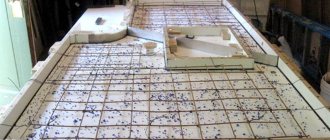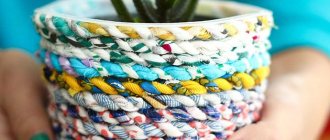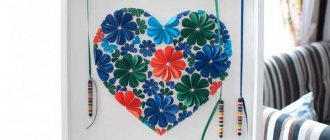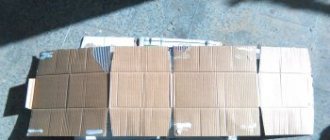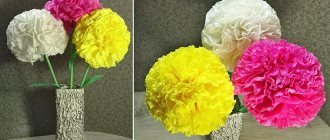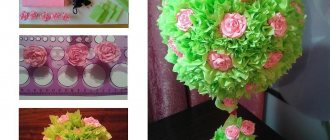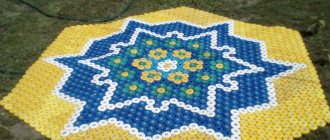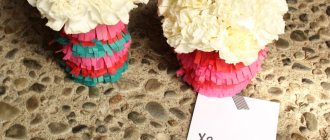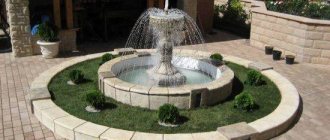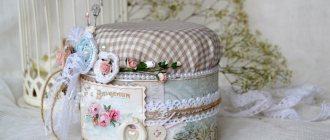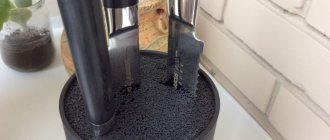Cement. Photo Megastroy
Decorating interiors and landscapes is a fascinating activity, ideas for the implementation of which can be realized independently. Various tools and materials can be used for this One of the popular solutions is cement. The use of accessible and inexpensive building material, which is quite convenient to use, allows you to create interesting in design, reliable and durable products . Cement flowerpots organically complement the garden and transform the interior space of a country house, cottage, apartment, office, commercial premises, hence the increased interest in these products. Items created in industrial conditions cannot always boast an attractive price, so it is recommended to consider the option of self-production . In addition, homemade flowerpots made of cement have a whole range of advantages and advantages over solutions made from other materials.
What you need to make a flowerpot from cement and rags
To make garden planters from cement with your own hands, you need to prepare the following materials and tools:
- Cement. Portland cement M400 is used to create street decor.
- Rags. This could be unnecessary tulle, lace napkins, old waffle or terry towels, burlap. More interesting and original ones are made from cement planters using rags with a relief structure. The dimensions of the product can be both large and small, it all depends on desire and imagination, any rag can be used.
- Paint. For concrete surfaces, it will be possible to use acrylic, polymer, and water-based epoxy. Vinyl compositions, as well as acrylic-silicone and lime compositions, have worked well for decorating cement pots.
- Paint brushes.
- Low-density polyethylene film, packaging - stretch film.
- Form for pots. This can be a conical bucket or another suitable container of any geometric shape. The main thing is that there are no difficulties with the removal of the finished product.
- Container for mixing cement mortar.
- Protective gloves.
- Lubricant such as paraffin, vegetable oil, machine oil.
- Electric drill with mixer attachment.
Flowerpots made of cement and rags do not require special experience; anyone can do it.
Some recommendations for making flowerpots from cement and rags with your own hands:
- The working solution is prepared from cement (1 part), sand (2 parts), aggregate (4 parts) and water (½ part). Alternatively, you can do without additives, but if you want to make a real work of art, then you should add polymer components, natural minerals with dyes with fine fractions to the solution. Thanks to decorative concrete, the pots are interspersed with natural stones.
- Reinforcing frame if the structure is planned to be large in size.
- Sander. It is necessary to give the front side of the pots perfect smoothness. The first time they use an emery wheel, and then a felt wheel with a special paste.
Advantages
The plasticity of cement mixtures and the high strength of the hardened material make it possible to create products of various shapes and dimensions : from simple pots to large flowerpots in the form of an open flower on a stem. Using cement, it is also possible to make flowerpots, vases for indoor plants, solid fences without a bottom for installation on the ground, and other types of flower stands. Flowerpots differ in the composition of the mixture (solution) , methods of production and decoration, and the presence or absence of reinforcement. But regardless of the type, flowerpots have the following advantages:
- any person who is not afraid to work with his hands and has enough imagination has the opportunity to independently create or improve a product he likes;
- Cement containers, compared to plastic and metal, retain moisture better and heat up less in the sun;
- durable;
- resistant to mechanical damage: shocks and scratches;
- do not corrode;
- do not collapse under the influence of ultraviolet rays, humidity, or negative temperatures;
- the ability to produce both mobile and not too bulky, as well as stationary options;
- the ability to create a flowerpot of exactly the shape that best suits the landscape design;
- especially convenient to use outdoors.
How to make a flowerpot from rags and cement
There are many variations of making unusual flowerpots from rags. You need to decide on the form and adhere to a certain algorithm of actions.
Simple planter made of cement and fabric
Master class on making cement pots:
- Cover the workpiece for future garden decor with plastic film. This material will facilitate easy release of the finished flowerpot.
- Prepare the working solution in a suitable container. First, clean water is poured into the container, and then cement is poured. For ease of mixing, it is recommended to use an electric drill with a mixer attachment. The consistency of the composition should resemble sour cream.
- Immerse a rag or burlap in the working solution. The material should be completely in liquid cement, it is advisable to leave it in it for 2-3 minutes.
- Stretch the rag over a bucket or any other container, straightening the edges. Imitation of folds on a flowerpot will look good. The time for the rag to dry completely is 3 days.
- Decorate the concrete decor from a rag with paint.
Planters made of gloves and cement
The step-by-step process of making original garden decor involves the following steps:
- Mix the working solution according to the instructions described in the previous case.
- Filling gloves with cement composition.
- Placement of workpieces for drying. They need to be laid so that they bend slightly, as if holding something.
- Removing gloves after the cement has hardened.
- Coloring pots as desired.
Modern trends in landscape
Concrete flowerpots add a special presentability to the owners of a garden, cottage or estate.
Flower bowls both decorate the area and perform the function of a flower garden: they house both floral and decorative crops.
Both annual and perennial plants are planted in flowerpots.
Trends in decorating local areas dictate to home garden owners that bowls and flowerpots be made from materials that closely resemble natural ones.
Decorating cottages and courtyards from natural stone is not an easy and expensive job. It has become practical to use ordinary concrete and cement mortar to create flower arrangements.
Designers consider concrete vases not only original, but also functional. With the help of volumetric bowls you can:
- Create a special aura on the site.
- Concrete vases can be used to zone a space, collecting its details into the overall picture.
Massive flowerpots are actively used by decorators in private plots, parks, at the entrance to cultural institutions, and in administrative buildings.
Concrete bowls have many advantages that make them popular:
- vases are affordable, their construction or purchase will not break the budget;
- concrete is not afraid of moisture, frost, flame, it is quite durable;
- availability of bowls (vases, etc.) for the implementation of all kinds of ideas: vases can take on any, the most bizarre shape;
- environmental friendliness and mobility: green spaces grow well in such vases; for capricious plants, you can choose an exclusive area for mounting the bowl;
- outdoor vases can be created in the style that the customer prefers;
- Concrete is easy to paint and can be finished, so flowerpots can be decorated in any color scheme.
Useful tips
To achieve results when making flowerpots from cement and rags, you should adhere to the following tips:
- If there is a need to trim any of the edges of the flowerpot, you should use a large sanding mesh for drywall. A regular hacksaw is not an effective solution here; the edges will stand out too much from the general background.
- To decorate flowerpots made from old jeans, it is better to choose metallic acrylic paints. Bronze and greenery will look more advantageous.
- For ease of painting the finished product, white sand should be added to the working solution. Alternatively, you can cover it with plaster.
Video on creating flowerpots from cement and rags:
Making a flowerpot. Master Class
Everything will depend on how big the flowerpot you want to make. Let's look at a specific example.
- If the product is large, you will need a plastic mold with a diameter of 53 cm and a height of 23 cm. White cement, perlite (agroperlite), and peat are used for the solution. The proportions are 2:1:2. A 1.5 liter ladle can be used as a measuring container.
- It is necessary to dilute the mixture with water to obtain a thick mass. The flowerpot is heavy, so it must be made in the place where the bowl is supposed to be installed.
- It is worth preparing a plastic mold (internal).
- You need to put a 5 cm layer of solution on the bottom. A regular toothpick is suitable for measurements.
- To give the structure strength, you need to provide a wire frame. Since the container is large, at least four batches of cement will be needed.
- The plastic pot should be wrapped in cellophane and then inserted into the first (large) mold. All folds are carefully straightened. The solution is laid around the plastic pot.
- It will take at least 8 days for such a bulky container to dry completely.
Then the flowerpot is pulled out of the mold and cleaned with a brush. After this, the vase is washed and dried thoroughly. Next, the product is wrapped in cloth or damp burlap and left to harden further. When the material becomes light, this will mean that the bowl can be used.
What is needed for a universal flowerpot
We list all the material that will be needed to create a universal flowerpot:
- Concrete. An excellent solution is to purchase the mixture ready-made in the store.
- Molds and molds. It's worth imagining. You can’t just focus on certain standards. The main requirement is that the shape must be comfortable so that the product can be easily taken out of it. You can use different containers: packs of cardboard, cups, all kinds of glass containers, basins, jugs.
- Non-stick spray. Concrete containers will be easier to remove if treated with a spray before pouring. Motor or vegetable oil is also suitable.
- Water for preparing the solution. Not hot and not cold, but always warm and in fairly large volumes.
- A rod that is identical in thickness to a pencil. It is needed to remove air bubbles.
- A special stirrer (an ordinary garden shovel will do).
- Rag for creating a fabric flower box. What you need is thick fabric.
- Buckets and various containers that can then simply be thrown away.
- Shards of ceramics and paint for decorating a flowerpot.
Reasons for choosing a concrete flower bed
Absolutely any flower pot can be divided according to specific functionality, as well as specific placement. Concrete flower beds are no exception; they can be:
- Indoor. This option is less common. Typically, concrete planters are used only in very large houses, as they take up a lot of space and clutter the area.
- Decorative. These samples are coated with special paint or decorated with additional elements on top.
- Street. Such flower beds are made without decorative elements and usually have only preliminary processing without frills.
Various types of materials are used to make flower beds, and some of them are used in all three varieties described above. We are talking about a concrete structure.
A concrete flowerbed is an ideal option for decorative arrangement of an open areaSource kmgram.com
But there are also other manufacturing materials, for example, wood, plastic or clay. Each of them has both advantages and disadvantages. To purchase the right flower bed, you need to start from your desires, as well as your financial capabilities. But a concrete flowerbed is rightfully considered universal, since it adapts to any interior style, and can also be made in absolutely any shape.
Shape of hardened concrete towel
To create a product of an unusual configuration, any material that retains its original appearance for 5 hours is useful. After polymerization of the composition, the structure becomes stable. Thick cardboard, plastic products, plywood boards, and towels are often used to make molds.
The cement mixture for pouring should not be too liquid, so when preparing it it is better to achieve the consistency of thick sour cream. Cover the bucket with a towel and turn it over so that the concrete saturates the inside.
The length of the fabric blank should be adjusted before pouring the concrete. The towel is completely lowered into the bucket and soaked in the composition. When the task of saturating the fabric is completed, the towel is thrown over the bucket and left to dry. The average curing time is from 48 to 72 hours.
When working with cotton fabric, cement tile adhesive is used instead of concrete. It is recommended to choose quick-drying mixtures intended for outdoor use that are resistant to temperature changes.
The prepared rags are thoroughly moistened in the solution, wrung out and again immersed in cement. After impregnation, they are hung, draped on the body of the form, trying to give an interesting configuration. Beautiful texture is inherent in burlap products.
Imitation wicker basket
Using cement mortar and scraps of fabric, you can make a designer item. Flowerpots that look like wicker baskets look very beautiful. A plastic bowl is best for the base. It should be wide enough to look like a basket. You need to turn the bowl upside down and place a rag soaked in cement mortar on it. Any cotton items that are out of use will be used: sheets, towels, T-shirts. You need to make strips no more than 15 cm wide from waste fabric, soak them thoroughly in the solution and lay the strips in rows on the surface of the bowl. You can twist them a little, intertwine them with each other
It is important to carefully work the edge of the pot so that the plastic base is not visible. Dry thoroughly for several days
It is easier to paint the dry surface of the product using an aerosol can. Paints are preferred in natural shades: ocher, cream, straw, brown. It will look very nice if you paint the basket with black paint.
Materials
The main material in creating a flowerpot is concrete. This composition consists of:
- crushed stone;
- sand;
- cement;
- water;
- special additives.
The binding component is Portland cement, which includes clinker of the same name, gypsum, slag, ash, pozzolans and other mineral inclusions. Other types of Portland cement are expanded clay concrete (crushed stone is replaced with expanded clay) or sand concrete (the function of aggregates is performed by mixed-grade sand). The water for mixing the composition can be different: drinking, ground, technical, sea (not suitable for reinforced concrete flowerpots).
In addition to the main raw materials, auxiliary and decorative materials are used in the work. The first category includes improvised means with which you can make a flowerpot. These are a variety of items that can be used as a form of a flowerpot, as well as a load that allows you to achieve the desired thickness of the product. Some of the most interesting and unexpected solutions include:
- large and small empty food boxes;
- used plastic bottles and buckets left over after renovation;
- old basins, buckets, tubs;
- rubber gloves for cleaning (high density);
- wooden boards, cardboard, dishes;
- metal rods, wire;
- old towels, rags or other fabric of rectangular, square, round, oval shape;
- old shoes, children's toys of the right sizes;
- boxes from furniture that has fallen into disrepair.
Mostly small stones are used as a load: due to their size, they perfectly fill the internal part necessary to give the flowerpot its shape, and also act as a load with low weight. These raw materials can be found in any garden or area of a country house. If you have problems finding it, you can use sand, which is also heavy and has a small volume.
Decorative elements of a concrete vase depend on the stylistic idea. In the classic version, the flowerpot may not have any decor at all: the emphasis can be placed on the unusual shape, because the abundance of decor does not always look harmonious with the flowers or other plants that will be in the flowerpot. The most interesting raw materials for finishing are glass, coins, small multi-colored stones, rhinestones, mirror fragments, stained glass and paints.
Connoisseurs of creativity use natural materials in their work, conveying the unique texture (for example, green leaves) of the concrete surface.
Square pots with gilding
Typically, concrete pots are left uncovered: this makes them look more authentic. But why not play with their appearance? With the help of simple paint, faceless gray concrete can be turned into a decoration not only for minimalist interiors, but also for rooms in the Empire style, ethnic style, and so on.
The manufacturing process is similar to that which has already been described many times above. Square pots are best suited for painting. They are easy to use stencils on. After the cube pot is ready, you need to:
- Wait at least 4 hours for the concrete to set. Remove from the mold.
- Cover with white paint. If you choose a paint with the addition of fine sand, it will help hide minor surface irregularities. In this case, you will be able to do without thorough sanding, but before applying the substance, it is still recommended to go through the corners with a file.
- When the first coat of paint has dried, apply a second coat if necessary. This may be necessary if the paint is translucent and the gray base shows through.
- Wait for the paint to dry. The drying speed and time required to apply the second coat are indicated on the packaging. Usually it is 12 hours.
- Cut out a stencil from cardboard. You can repeat the pattern in the photo or use your own sketch. Using metallic paint in a gold or bronze shade, apply the design through a stencil.
Such a pot will delight the eye for a long time and is suitable not only for strict men’s interiors, but also for elegant women’s bedrooms.
Advice!
Since concrete is porous, it is best to use a thin layer of primer before applying paint. This way the paint will adhere better, and you won’t have to renew it in a couple of years.
You may be interested in:
How to decorate and illuminate garden paths in an original way? With the onset of the spring-summer season, summer residents clean up their garden plots. They plant flowers and trees,...Read more...
An easy way to create original jewelry
Spring has come, it's time to plant flowers in balcony boxes and flowerpots. Good large flowerpots are expensive, they are heavy, and do not always meet our expectations in size, shape, and color. Lighter pots are fragile and not resistant to frost. An interesting alternative to purchased flowerpots are homemade pots made from concrete using various shapes and decorative methods.
It is important to choose the right size of pots. Dimensions depend on the dimensions of the mold used
- The wall thickness of a large container should be about 5 cm to ensure strength;
- for a small pot, a thickness of 1 cm is sufficient;
- for a large container with a width and height exceeding 50 cm, the minimum thickness is 7-8 cm.
Kinds
A concrete flowerpot is a decorative vase of small architectural form, which can be made of different materials. This is a beautiful pot for plants and flowers. It helps gardeners in cultivating particularly sensitive plants and allows them to select the optimal soil composition for each of them. The flowerpot also carries a decorative load: with it you can place bright accents in the landscape space, emphasizing the uniqueness of the garden.
Existing varieties are divided into several categories. Flowerpots are:
- street (garden);
- indoor;
- decorative.
Each type has its own characteristics, although in general the properties of the varieties are identical: the difference lies in the size and material used in each specific case. For example, garden flowers are often medium-sized.
Decorative models are smaller, they are displayed at the entrance, they are a unique component for giving the interior landscape the desired atmosphere. Small options are often moved around, so they are portable. Large models often resemble flower beds, differing in their shallow depth.
Let's sum it up
Instead of buying expensive flower pots, you can easily make your own. This work does not require special precision, skills, or equipment. An old bucket or pot found in the attic can start a new life as an unusual flowerpot. Concrete pots look good in the garden and are durable. Homemade flower pots can be imperfect, and that's the beauty of them. Plants grow well in them and look harmonious in modern gardens. Their small size fits into some modern styles.
Caring for concrete pots is as easy as caring for plastic pots - just wash with water. Homemade pots are not only an easy way to create a functional, original decoration, but also a lot of fun from the work done!
Beginning of work
In order to start working on a flowerpot, you must first create a drawing of the future product. After this, you can cut out a shape based on it, which will be determined by the prepared template or the one you created yourself. The workpiece is glued together. To make it durable, the entire surface is coated with glue.
- Initially, a composition of a certain consistency is prepared. It is important that the solution does not spread. To do this, take two parts of cement and 3 parts of sand. Add a little water to them. All components are thoroughly mixed until smooth.
- Once the mixture is ready, you can pour it into the mold.
- If you suddenly want to create a luxurious garden bowl from washed concrete, it is important to take into account the specifics of this material. Washed concrete contains naturally occurring stone. These are travertine, marble chips, quartzite, granite crushed stone and pebbles. It also contains artificial components. These are cast iron shot, smalt, glass chips.
It will be possible to create a durable and very beautiful texture.
But this can only be achieved through certain manipulations.
A mixture of concrete with the additives we listed above is placed in a mold. The half-hardened product must be removed and the top layer washed under water pressure. Cement. the sand will leave, the stone will appear.
It looks very unusual. But it is better to implement such an idea with professionals. You will create a product that is unique in color.
Round base
To create such a container, you will need round sponges. It is necessary to make a small recess in them, which will later serve for planting plants. Then the sponge is dipped in cement mortar. The result is a very light pot, and even a child can make it. Since the planting hole will be small, you can only place a succulent there.
Planter under a wooden bucket
It’s not hard to figure out how to make such a pot: just use an old wooden bucket as a mold. You can put together something similar yourself. After the concrete has set, it needs to be decorated. Wood grains will not appear immediately; they need to be created using a cutter. The overlay imitating a metal ring will also have to be applied separately. Finally, holes are made in the concrete for the rope.
It's a bit heavy to carry 10 and 20 kg pots. To make the structure lightweight, foam should be used as a second filler. This tip can be applied to any design.
